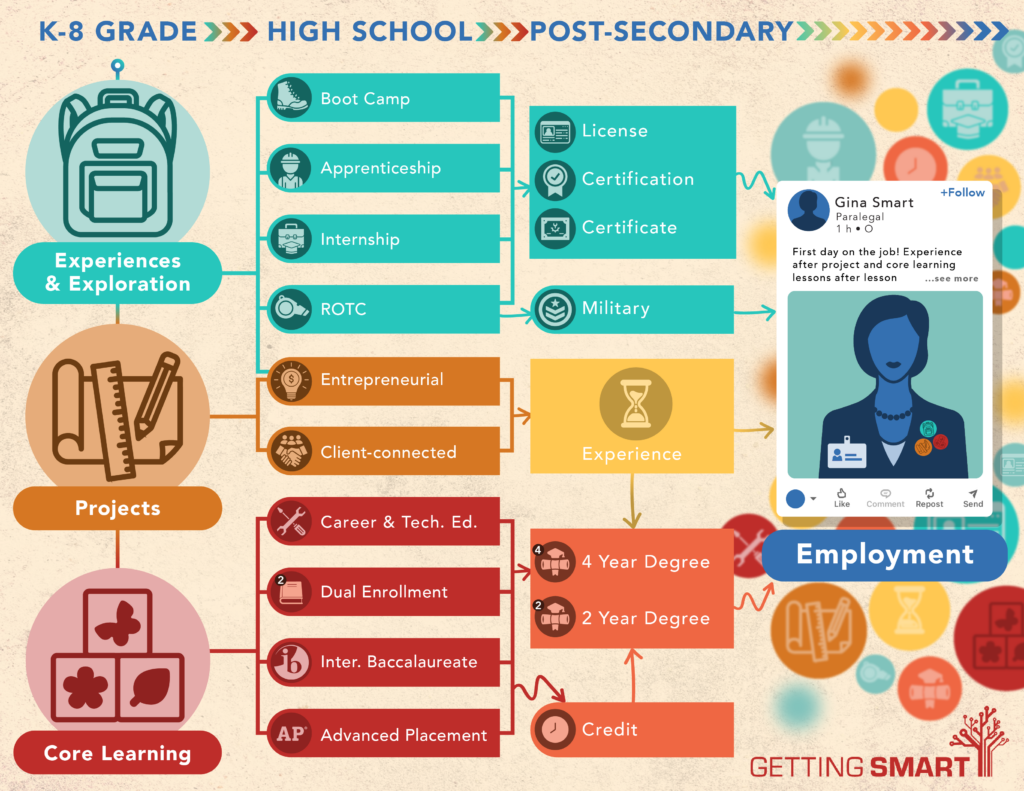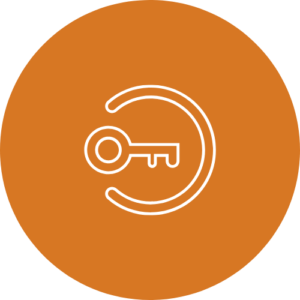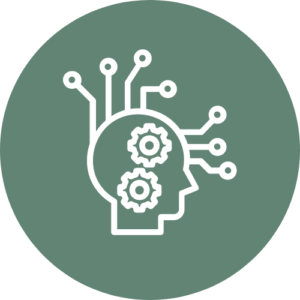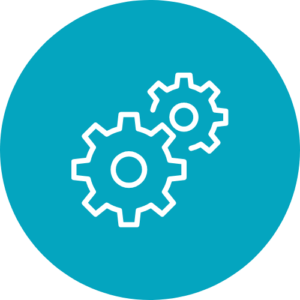Why New Pathways
Every learner needs access to new pathways. We must continue to keep their futures and interests at the center of any changes we make to the education system. Intentional, curated, equitable, and purposeful pathways help learners chart their path to a financially and socially secure future. Intentionally back-mapping work opportunities to secondary sequences driven by real-world experiences, credentials and college credit provides much-needed alignment between school and the world of work. Inviting learners to co-curate their pathways in partnership with educators builds ownership and agency as they create purposeful and meaningful learning experiences. Finally, a focus on access and accommodation ensures that all students have available pathways to not only build experience and skills but the social capital to secure their future.

Opportunities and Pitfalls
As school leaders design new pathways, consider the following opportunities and pitfalls.
- Pathways are inclusive. New pathways are not just for those who have decided not to attend college. Every student is on a pathway, and every pathway should be combined uniquely to earn the credentials and experience that lead to a family-sustaining wage.
- Options can be bundled in countless ways. Associate’s degrees earned through internship, apprenticeships leading to credentials, work-based learning for college-bound students are just a few of the ways in which one should consider new pathways.
- Access for all. Every student should have access to a variety of new pathways. This requires early awareness in middle school.
- Avoid dead-ends. Be wary of dead end pathways or low ROI pathways. Every pathway provider (degree, credentialing, coursework, certificates, etc.) should provide evidence of ROI both regionally and nationally.
- Connect to community and purpose. Building new pathways that focus exclusively on employment and income is not enough. Every student on a pathway should recognize the connection between employment, purpose, civic engagement, and community impact. While not every job will directly link to purpose, every job should open up opportunities for purposeful contributions.
- Collect long-term data. High school post-graduation data needs to be more extensive at the program and school level. Matriculation, first-year persistence, and six-year graduation rates are available in the higher education space but often not linked to schools or programs, which makes evaluation difficult. Building strong alumni relationships to track pathways to success for every graduate is imperative for high schools.
- Pathways build foundations. Building career awareness and transferable skill development programs as early as elementary school can, if connected and relevant, increase opportunity spotting for young people.
Change Indicators
We launched the book with a vision of how we see new pathways as a sea-change from traditional models. Let’s revisit our original elements to consider when designing new pathways. As you imagine what is possible, consider using the reflective questions and implementation guides below as prompts.
| Traditional High School | New Pathways | Reflective Questions | |
| Design | Learners receive an inherited list of required courses. | Experiences are created and mapped from localized and personalized opportunities. | How are courses chosen at your school?How are courses mapped to pathways? How much flexibility exists in those pathways? |
| Learner Role | Learners receive direction. | Learners are engaged co-authors in their learning. | Can a learner design their pathway? Can a learner modify an existing pathway?Can a learner complete a pathway not directly offered by the school? |
| Supports | Learners receive moderate course selection guidance. | Learners are given time and support to achieve and demonstrate mastery. | Do learners have flexible time to demonstrate proficiency, or is time fixed? |
| Learning model | Learners tell, test, and repeat to prove knowledge. | Learners are invited into community connected projects. | How is learning connected to real-world relevance? Are structures in place for learners to complete community connected projects? |
| Opportunity | Learners can select options from a course catalog. | Learners have access to unbundled learning opportunities both in and out of school. | How are opportunities outside of school curated and made accessible to learners? |
| Feedback | Learners receive grades based on knowledge. | Learners demonstrate learning through performance assessment. | When students participate in out-of-school experiences (work-based learning, internships, etc.), how are they assessed? |
| Guidance | Learners receive occasional and limited advising on the next steps. | Learners receive personalized and localized advice on next steps and possible futures | Does each learner have a coach/advisor to support pathway choice and completion? |
| Community Connections | Learners are only marginally connected to the world outside of the school. | Learners participate in relevant work experiences and gain social capital facilitated by the school. | How does the school measure social capital for each student?How does the school increase opportunities to build social capital for students? |
| Communication | Learners receive a transcript of courses and grades. | Learners accrue and utilize digital credentials in a portable learner record. | Do all students earn a certificate, course credit or credential valuable for higher education or the workplace?Is student learning recorded in a portable record owned by the student? |
| Time and cost | Learners participate in 4+4+ years of high school and college with weak articulation and coherence. | Learners participate in 1-2 years of accelerated progress to credential with strong articulation and coherence. | Can students earn transferable college credit in high school (dual enrollment, early college)?Do students have access to a map of pathway opportunities linked to ROI and time commitment? |
Progress Indicators
By mapping New Pathway development to the six pillars described in this publication, schools and districts can create strategic action plans to implement change. The table below describes simple and more complex wins for each pillar. When we think about change management, simple pillars may be more effective at first to create buy-in and proof of concept. Complex approaches can be implemented after proof of concept and coalition building.
As with any project, change management practices should be implemented. These include, among others, involving all stakeholders, building a collective vision, articulating goals and success metrics and celebrating every win.
Simple
- Increase course/pathway choice opportunities through virtual programs and local partnerships (higher ed or business).
- Develop teacher capacity in learner-centered classroom approaches to allow students to unbundle traditional curriculum at the classroom level.
Complex
- Students can link any experience to meet graduation requirements with the approval of an advisor.
- An active community opportunity database exists to match learners with relevant experiences.
Simple
- Students earn employer-valued credentials and certificates as part of graduation requirements.
- Students co-design high school and post-graduation trajectories with the support of a coach.
Complex
- A portrait of a Graduate/Learner exists with connected progressions of standards/competencies.
- Pathway choices are informed and connected to real return on investment that is understood by the learner.
- Learning experiences are linked to standards/competencies as well as owned/shared by learners via a digital wallet.
- Outcomes are tracked for all graduates over the first 10 years since graduation.
Simple
- The school pilots pathway structures in an existing learning environment for quick feedback and iteration.
- Students are invited as key stakeholders to co-create learning experiences, ensuring their voices are heard and valued in the educational process.
- The school prioritizes simplicity in implementation and focuses on impactful strategies that benefit student learning.
Complex
- The school develops implementation plans for personalized learning pathways as part of a district strategic plan.
- The school establishes a clear vision to support various learning models, with input from all stakeholders, including students. Regular monitoring mechanisms are in place to assess effectiveness and make data-informed adjustments as needed.
- Both instructional leadership and teachers commit to ongoing evaluation and adaptation of programs that support a learning model, ensuring they effectively support the designated student outcomes.
Simple
- The school has conducted a needs assessment to identify the interests and demands of students, parents, teachers, and community stakeholders.
- The school has documented best practices from successful and related programs that align with chosen pathways.
- The school partners with local colleges, industry partners, community organizations, and businesses around pathways.
- Dual enrollment programs or competency badging mechanisms provide students with a pathway to earning college credits or demonstrating mastery in specific areas, further enhancing their academic and career readiness.
Complex
- The school has outlined the goals, objectives, and strategies for implementing accelerated pathways, including selected pathways, learning models or frameworks, supportive services, resources, and a timeline for implementation.
- Professional learning is an option for educators and leaders to effectively support accelerated pathways and build sustainability with ongoing evaluation and refinement.
- Students co-design personalized learning pathways aligned with their interests, career aspirations, and academic goals.
- The school partners with local colleges, industry partners, community organizations and businesses around pathways.
Simple
- Every student has access to a well-informed advisor who understands all offered pathways.
- The school emphasizes that every student has access to every pathway and that pathways can be combined in unique, learner-centered ways.
Complex
- Every student is assigned a coach to support secondary choices and post-secondary plans.
- The school employs a partnership manager to build relationships with local and regional employers for real-world experiences.
- All students have access to an AI-supported technology tool that is connected to local, regional, and national career outcomes and return on investment for certificates, credentials, internships, apprenticeships, bootcamps, and degrees.
Simple
- Establish partnerships with the business community to support the marketing of these options and provide support through internships, apprenticeships, and potential scholarships (earn/learn).
- School leaders stay current on local policies impacting high school learning pathways for students.
- The district leadership advocates for state-level policies that establish partnerships between state departments, local businesses, and educational institutions.
Complex
- The school/district/region has created a diploma/curriculum network that supports districts/schools in adopting new pathways and facilitating real-world learning experiences.
- The school has established sustainable funding mechanisms to scale up pathway initiatives and ensure equitable access for all learners.
- The school (district/region) advocates for state-level policies that promote flexibility and innovation in education, allowing for the development and expansion of diverse learning pathways.
Conclusion
For too long, too many high school students have graduated into low-paying jobs with little opportunity for advancement or matriculated into degree programs with low probability of graduation but high probability for debt. New pathways open up transparent opportunities for every learner to earn the credentials needed to earn a family-sustaining wage and contribute to communities. With the current significant attention and investment at the local, state and federal level, the opportunity is high for every school to build a high quality new pathways program. Let’s keep up the good work.







